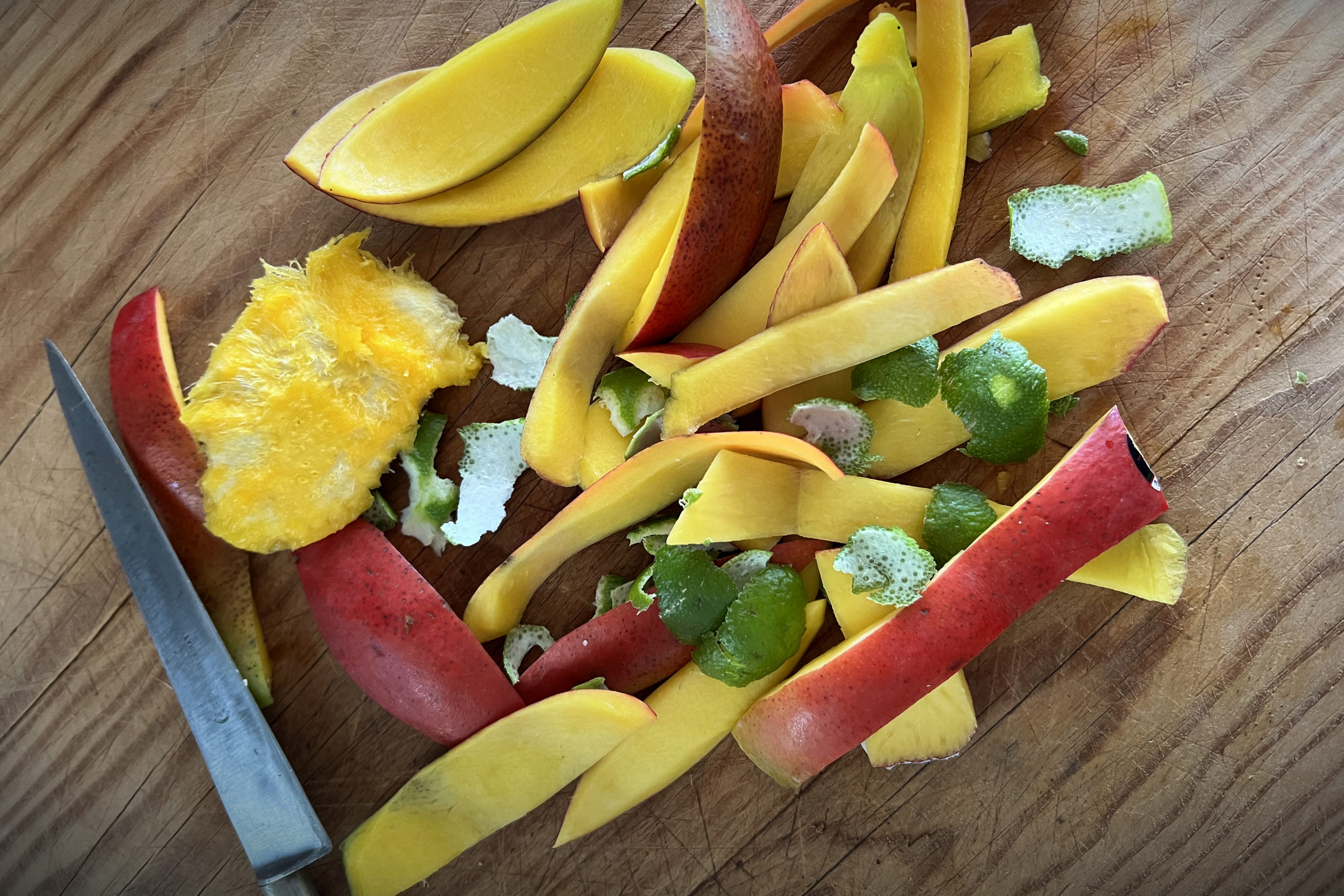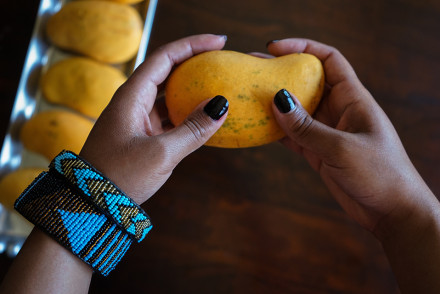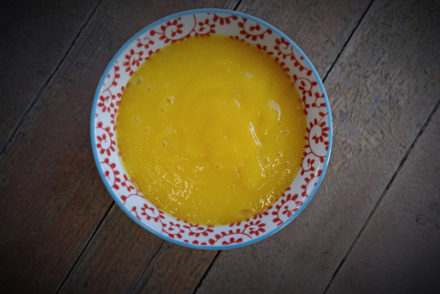
A flavor-laden libation syrup made from mango peels
I love the exploratory process of creating new recipes, getting to travel through so many unknowns as I connect ideas and ingredients. Exploring new and unfamiliar possibilities with my creativity fills me with incredible joy. This new recipe brought a lot of joy in the creation process and in the enjoyment of the drink, which I’m currently sipping on whilst I type.
This recipe’s seed was planted when I saw Mango Hunter, Jeff Ray, making mango oleo-saccharum. I was immediately brought back to my Brooklyn days and one particular cold winter night at the Clover Club (great bar then and now), which was the first time I tasted an oleo-saccharum in a drink. I hadn’t known its proper name until I saw Jeff’s post and googled oleo-sacchurum.
Oleo-saccharum is a fairly old idea. It dates back to the 1800’s. It’s also quite genius in its ability to capture a potent concentration of citrus flavor. It continues to make progress in a comeback, and I hope this helps. I for one will be using its idea in several avenues of my culinary life. (Herbal-Roots herb salts!)

The Latin words translate to oily (oleo) sugar (saccharum) and the simple, two-ingredient syrup is made by combining sugar with citrus peels. The absorbent nature of sugar extracts the oils (and with it all the differing nuances that live inside the peels and pith of citrus). The end result is a sweet, citrusy syrup that has potent citrus zest flavor, loaded with complexity and depth of character.
Jeff’s use of mango peels is equally genius and got my recipe creation wheels turning in terms of the knowledge and knowledge of how I might be able to contribute to improving this recipe, specifically for use in mangoes.
Mango peels are not as oil-rich as citrus, so I decided to take his idea into a slightly different direction in order to create a final syrup that was more potent in tropical mango with more complexity rather than just a bitter mango peel note, which I wouldn’t be mad at by the way.
Instead of using a peeler like people do when they make oleo-saccharum with citrus (so they can extract more peel and as little pith as possible), I went for the PEEL & SLICE mango cutting method, deliberately leaving more mango flesh on the peels. My assumption behind this idea, which was proven correct, was that the fresh mango left on the peel would add more fresh tropical mango flavor that I wanted to shine in the final syrup. The thought was that the bitter flavor of the mango peels and tad of the camphor flavor peels are known would create a more enjoyable overall syrup when coupled with the fresh mango flavor.

Mango peels contain high levels of urushiol, which is an oleoresin (there is that oleo word again) or semi-solid compound found in their sap. Interestingly, this is the same compound found in poison oak and poison ivy, which is why people who are sensitive to poison ivy and oak should not tamper with or ingest anything using mango skin. Many folks with this reaction shouldn’t even touch mango skin.
The oleoresins in mangoes contain very large amounts of vitamins, flavonoids, polyphenols, carotenoids, and antioxidants. There is a wave of researchers studying how to extract these nutrients before they go to waste by our non-use of the peels. I think that’s very exciting. It also gets me thinking about how I can further develop healthy recipes that include the peel extractions.
I wasn’t going to be satisfied with just a bitter tropical syrup. I wanted even more flavor and depth. I wanted something that felt special and more Mexican. So first, I added lime peels thinking they would impart a lively, bright fresh citrus component. I also broke apart and tossed in a chipotle pepper, seeds and all. Once I added the sugar I kept it on my counter for 4 days, longer than regular oleo-saccharum recipes, shaking it every time I passed by it and thought about it. I opened it up once a day to smell it and its olfactory changes memorized me. It was an enchanting project that made me smile a great deal. It was on the fourth day when I could finally smell the heat of the chipotle mingling with the lime, mango, and camphor, which began to smell more cinnamon-esque. The scents were separate but commingled, signaling that it was done.

I strained it and bottled it up and stashed it in the refrigerator. The high potent version should last about a week in the refrigerator. After that the flavor weakens.
The end result is an opulent mango-licious gentle yet complex syrup. It’s a teensy-bit spicy and has an earthy sultry vibe I totally adore. Like many of my favorite recipes, it isn’t overtly mango. The mango acts like an accent, lending its sweetness and tropical flare to what I can only describe as an Angostura-like syrup, which is made with some secret fruit, so who knows!

Kitchen Tip: Don’t toss out the peels. You can create beautiful, candied mango peel garnish. Lay the used mango-oleo peels flat on a cookie sheet lined with parchment paper and place them in a 230 degree F oven for 1 hour. Turn the oven off and let stand for 3 more hours. Store in a bowl on your counter while you use them as garnish for your drinks!

Mexican-Mango Oleo-Saccharum
Makes about a cup of syrup
I recommend peeling your mangoes with the Cut & Slice Method in order to leave a bit more mango flesh on the peels. But for the lime, use a regular peeler and try not to include much pith with the peels.
In a citrus oleo-saccharum it’s customary that you muddle or pound at the peels after sprinkling the sugar over; since mango peels are so thin and have less oil content than citrus, you can get away with not muddling. For this recipe it will be important to shake the mixture, essentially extracting more oils, juice and flavor as the mixture macerates.
Using a mason jar to make this recipe is ideal.
Ingredients
Peels of 1 fresh mango, leaving some flash on the skin
Peels of 2 limes, try for very little pith
1 dried Chipotle chili, broken in half
1 cup sugar
Directions
Place the mango and lime peels in an empty mason jar and toss the chipotle on top. Add the sugar and muddle a little bit to get the extraction process going.
Close the lid and leave the jar on your counter where it’s not too hot. Shake the jar a few times a day for four days to help the extraction process. Open the lid at least once a day take the opportunity to smell the changes. This also helps relieve and even slight pressure from building up.
Strain out the peels, pressing on them to extract all the oils and juices. Place the liquid back in the mason jar and refrigerate. Use the peels to make Candied Mango Peels.
Shake the mason jar of mango oleo-saccharum gently before using to mix the oils up.

The Mexican Old Fashioned
Makes 1 drink
My version of this drink uses my new favorite whiskey, Abasolo. From my absolute favorite Mexican spirit maker Casa Lumbre Spirits, who produces not just exceptionally crafted booze but spirits that pay respect to the traditions and culture of Mexico.
Abasolo is a Mexican corn whiskey made with 100% Mexican Cacahuazintle corn, which is an heirloom corn that originates from Toluca, Mexico (the birthplace of corn). It has tremendously complex and distinct flavors. The variety of corn is also prized for the best pozole corn.
The whiskey is rich and smooth with fine layers of complexity. The profile feels to me of honey, vanilla, smokey sweet corn, and bergamot flowers.
The mango oleo-saccharum has plenty of bitter tones from the mango skin so I forgo the normal traditional bitters here. The drink is complete without it, but you go the extra mile and add one or two of my mango-schino cherries that take this Mexican Old Fashioned experience to the next level.
Ingredients
Rocks glass
Big ice cube
2 ounces Abasolo Whisky
1 ounce Mexican-Mango Oleo-Saccharum
Orange peel
1 mango-schino cherry (or regular cocktail cherry)
Candied Mango Peel* garnish

Directions
Place a big ice cube in a rocks glass and pour in the whiskey, followed by the mango oleo-saccharum. Gently stir. Gently drop a mango-schino cherry inside. Express the oil of an orange peel by twisting it over glass. Garnish with a Candied Mango Peel.

Mango-schino Cherries
Makes 2 cups of cherries
One of my most clever mango recipes is my Mango Pit Syrup, which is a simple syrup that utilizes all the tropical flesh left on the mango that’s way too hard to extract. The syrup is only slightly mango-esque and tropical perfumy. It can be used to sweeten anything from teas to cakes, and I have used everything from sugar to honey to rice syrup to make it. In this recipe, we morph it into a poaching liquid to first soften cherries and, eventually, the syrup that said cherries bask in for a luxurious and slightly spiced maraschino alternative. It’s sultry and easy to make at home. Cherry pitter is required; though, I use an olive pitter (same thing).
Ingredients
½ cup sugar
2 tablespoons brown sugar
¼ teaspoon ground cardamom
¼ teaspoon freshly ground nutmeg
¼ teaspoon finely cracked white peppercorns
¼ teaspoon salt
Zest of 1 lemon
1 cup boiling water
3 mango pits with flesh
5-6 cherries, pitted and finely chopped
Juice of 1 lemon
½ teaspoon vanilla
½ teaspoon almond extract
1 cup pitted fresh cherries
Direction
Combine the sugars, spices and zest in a heavy bottom saucepan on medium-heat. Continuously stir the sugar, using a wooden spoon for about 45 seconds to a minute. You don’t want the sugar to burn or melt but it will begin to appear coarser as it heats up and begins to cook and melt. Cook it for another 30 seconds, stirring constantly and then gently pour in the boiling water and melt the remaining sugar.
Once the sugar is fully dissolved, add the mango pits, chopped cherries and lemon juice. Let the mixture boil for 3-4 minutes and then reduce heat and simmer for 10 more minutes. Turn off the heat and allow it to cool slightly. Strain and discard the solids. Place the liquid back in the pan and add the pitted cherries. Bring to a boil and then reduce the heat and simmer for about 3-5 minutes or until the cherries are a desired softness. I prefer them a bit firmer, while others a bit softer. Take of the heat and cool completely. Once cool, place the syrup and the cherries in a mason jar and refrigerate for up to 8 weeks.








No Comments